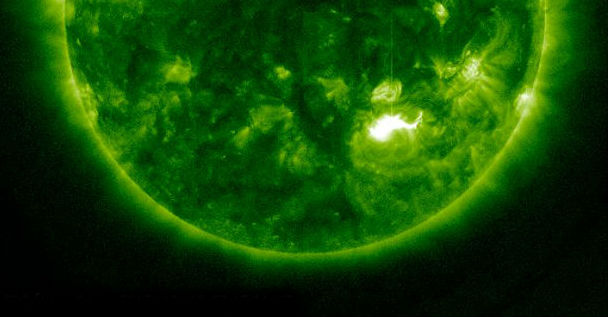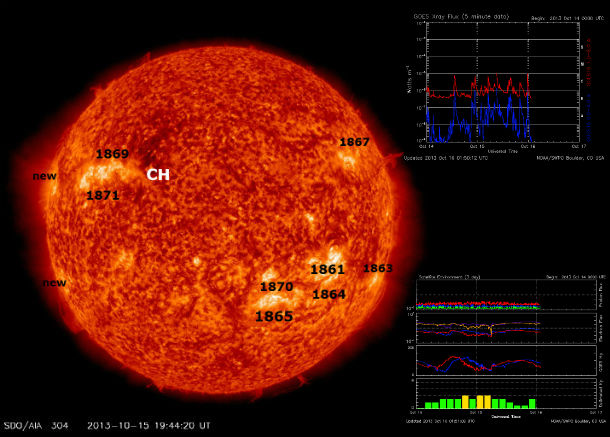Sunspot 1865 produced an impulsive M1.3 flare

Sunspot 1865 produced an impulsive M1.3 solar flare at 23:36 UTC on October 15, 2013. Due to the location of this region, solar plasma could be Earth-directed. This same sunspot already produced M 1.1 flare earlier in the day. Sunspot 1865 has a 'beta-gamma-delta' magnetic configuration and is capable of producing X-class solar flares. NOAA/SWPC forecasters estimate 30% chances for an M-class, and 1% chance for an X-class solar flare in the next 24 hours.
.png)
GOES X-ray flux plots (Credit: NOAA/SWPC)
Solar activity has been at moderate levels in the past 24 hours with many C-class flares detected mainly from sunspots 1865 and 1861 as well as from new approaching region behind the east limb.
.jpg)
SDO's AIA 094 recorded M 1.3 flare late on October 15, 2013 (Courtesy of NASA/SDO and the AIA, EVE, and HMI science teams)
There are currently 8 numbered sunspots on the visible solar disk and two new are about to be numbered. Sunspots 1861 and 1865 are capable of producing strong Earth-directed solar flares. Both sunspots are rotating into the western hemisphere of the Sun, so the risk of proton events at Earth has increased. New active region is now about to rotate into view off the eastern limb. A number of coronal mass ejections originating from this region were observed during the past couple of days, including a bright backsided partial halo CME on October 14, 2013 at 22:00 UTC.

SDO AIA with active regions, EVE, X-Ray flux and satellite environment plot data for October 15/16, 2013 (Credit: NOAA/SWPC/SDO)
Geomagnetic conditions have ranged from unsettled to active due to the fast speed stream from a coronal hole. The possible arrival of the CME from October 13 could raise the geomagnetic conditions up to storm levels late on October 16 followed by possible ejections generated from AR 1865 on October 15, 2013.
Featured image: SDO's AIA 094 recorded M 1.3 flare late on October 15, 2013 (Courtesy of NASA/SDO and the AIA, EVE, and HMI science teams.

Commenting rules and guidelines
We value the thoughts and opinions of our readers and welcome healthy discussions on our website. In order to maintain a respectful and positive community, we ask that all commenters follow these rules:
We reserve the right to remove any comments that violate these rules. By commenting on our website, you agree to abide by these guidelines. Thank you for helping to create a positive and welcoming environment for all.